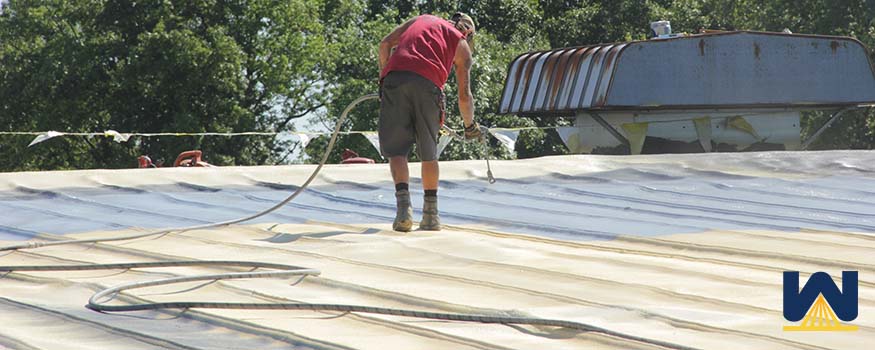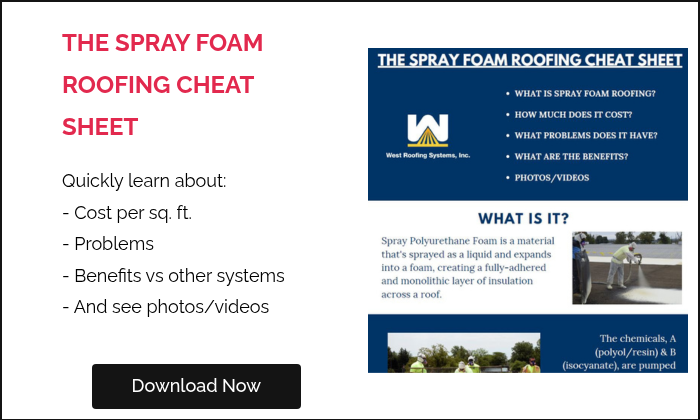Have a metal roof that’s leaking? Don’t want to pay for a complete tear-off and replacement? If so, you’ve come to the right place.
In this article, you’ll learn about spray polyurethane foam roofing. You’ll learn how it gets installed over a metal roof.
You’ll also learn the other reasons (such as R-value and filling in pinholes) why metal roof owners choose spray foam.
Here’s a start-to-finish video of spray foam being installed over an existing metal roof:
At the end of the article, there are three case studies of metal roofs we’ve done. Learn from them, take it all in, and see if foam might be a good fit for your roofing situation.
And just so you know, West Roofing Systems has been installing spray foam roofs since 1979. We install foam over every type of existing roof, including metal.
Lastly, every piece of content is reviewed and edited by a spray foam roofing expert with more than 30 years in the industry.
Let’s get started!
What is Spray Polyurethane Foam?
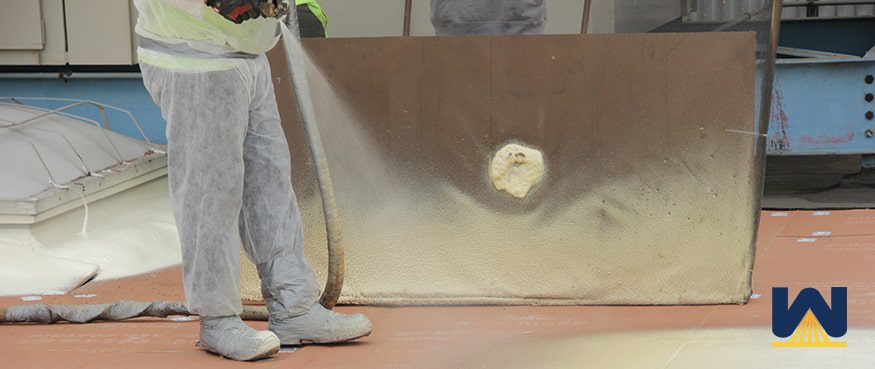
Most people have never heard of it before. Spray foam is a combination of two materials, a polyiso and a resin that get pumped from 55-gallon containers, through a hose that runs up the side of your building.
They combine through a spray gun and what comes out is a liquid. It’s fluid-applied and expands 30 times its size within a couple of seconds. It cures around 1-2 inches in thickness.
UV rays will degrade foam within 72 hours, so any roofing contractor that does foam will install a coating over the top of the foam to protect it.
There are several different kinds of coatings. The most common is silicone. It’s the best combination of performance and cost, especially here in the Midwest.
Two coats of coating go down. The first one goes on over the foam roof and they let it cure. Then a contractor will install the second coat of the coating and before it fully cures, they’ll embed granules into it.
This adds strength to the roofing system and also gives it some stability because silicone coating on its own is very slippery.
Can spray foam be installed over a metal roof?
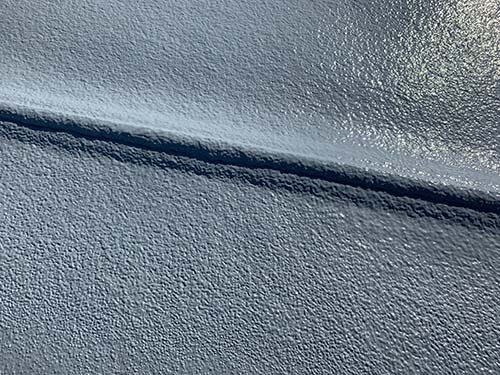
Yes, we’ve done hundreds of spray foam over metal roofs since we’ve been a company starting in 1979.
A contractor begins by examining the current conditions of the metal roof. They will check for rusted and deteriorated panels, check the securement of panels (screws) and flashings.
There’s prep work such as power washing. A primer may be involved. It just depends on the condition of metal the foam is going to adhere to. And that’s it!
Once the roof is properly prepared, a contractor can start installing the spray foam roofing system.
Why do metal roof owners do it?
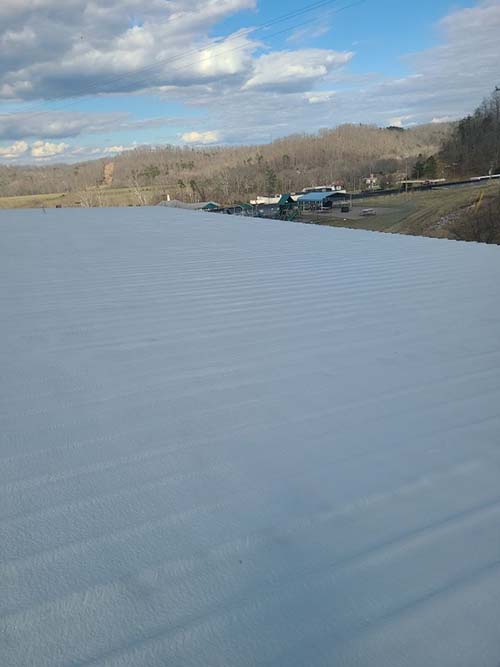
The #1 advantage is that you don’t need to remove the entire roof. It’s very costly to do a complete tear-off on a metal roof, transport all those metal panels to the landfill, and then install another metal roof.
It’s more cost-effective to leave the areas that are in good condition.
All you need to do is minor repairs and then install the foam roofing system over top.
Another benefit is that spray foam is fluid-applied, which means it’ll fill in all the tiny pinholes that a metal roof can have. It’ll cover all the rust and stop the rust from progressing.
Also, metal roofs have a lot of seams. These can pull apart, get damaged, and create water entry points over the life of the roof.
But with spray foam being fluid-applied, the seams will be covered, leaving the roof seamless. This means there’s no opportunity for water to get into your roofing system.
Another benefit is R-value.
Spray foam has an R-value of 6.5 per inch of thickness, which is the best of any roofing insulation out there. You should expect a reduction in your future energy costs.
Once the warranty is over, a contractor can make simple repairs, clean the roof, and install more coating. Once this is done, you’ll be granted a brand-new warranty. The foam itself does not lose any R-value over time. It’s a very sustainable roofing system. This is different than most other roofing systems where once the warranty is over, they’re in bad condition and need to be torn off and replaced.
Spray foam is the only renewable roofing system out there.
How much does a spray foam roof cost?
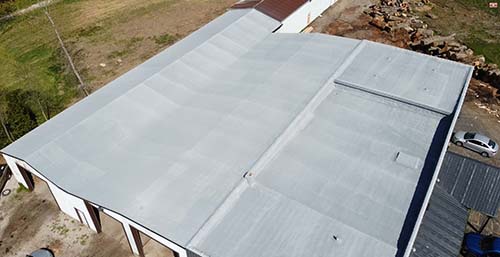
If we’re talking about the summer of 2021, spray foam roofs usually cost between $4 and $7 per square foot.
But with the product shortages and the supply chain issues currently going on, everything costs a lot more. I don’t have a general range because there are so many different variables.
But here are some variables that will affect the cost of a foam roof:
How long have a warranty you would like?
A 10-year-warranty takes 20 mils of coating to protect it, while a 20-year-warranty will use 30 mils of coating to protect it. When you’re using more coating, it’s going to cost more.
How much R-value are you trying to get out of your new roof?
If we need to install two inches of foam versus installing four inches of foam, that’ll affect the cost.
How large is your roof?
Setup charges and overhead expenses are the same whether it’s a 1000-square-foot roof or a 100,000-square-foot roof. The larger your roof is, the lower the cost per square foot.
Is a man lift required to install the roof system?
This depends on the slope of your roof. Using a manlift will increase the cost of the project.
What alternatives are there?
Besides spray foam, you can always rip off all the metal panels, transport them to a landfill, and install a brand-new metal roof. It might not be cost-effective, but it’s certainly an alternative.
If your metal roof is in good condition, you can install a silicone roof coating system over it. This will cost slightly less than a spray foam roof, but there’s no R-value involved with a coating system.
A good rule of thumb is to get quotes for 2-3 different roofing systems. Get one for a spray foam roof, get one for a single-ply roof, and get one for a new metal roof.
See the costs. See what benefits each roof system will give you. Then make your decision based on what you learned about each option.
What problems can happen when installing a spray foam roof over a metal roof?
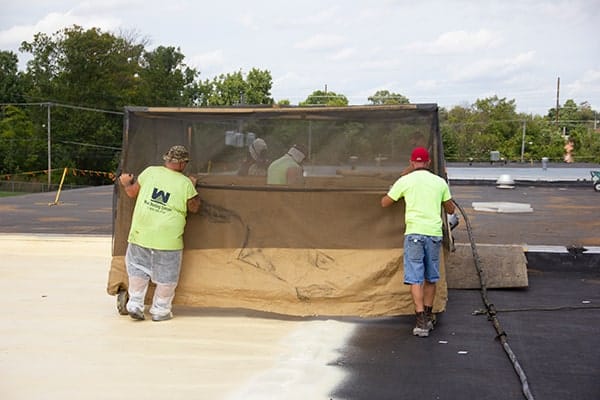
The first problem is wind.
Spray foam is a lightweight, fluid-applied product that can be blown away and land on undesirable assets such as car windshields and windows.
Although windscreens and spray foam booths minimize or eliminate that issue, it’s still something to worry about that other roofing systems can ignore.
The #1 problem is bad spray foam roofing contractors.
There’s a sweet science to applying good spray foam and when a contractor doesn’t understand the heating, cooling, curing, mixing, pressures, temperatures, and adjustments that are needed to install a good spray foam roof, problems can happen.
We’ve seen spray foam roofs that look like craters simply because the contractor didn’t know what they were doing.
Another issue is flush skylights.
Flush skylights will have to be covered over with metal or plywood. Because after the spray foam is applied, it will be higher than the skylight, creating a low spot that will hold water and create future issues. They can be raised, which will add additional cost instead of a lesser cost to cover.
Are there reviews or case studies of spray foam roofs over existing metal roofs?
Yes, here are three:
- MTD is a 384,000 square foot roof where we used three robots to install spray foam. They tested a 16,000 square foot area first and let it perform for five years. The results were favorable, so they went on and installed foam over the rest of the roof.
- West Roofing Systems installed spray foam over a metal roof at the Jabala Military Base in Iraq. The metal roofs had pinholes, and with temperatures exceeding 100 degrees every day, the HVAC’s cool air escaped through the roof. Spray foam was able to cover all those holes and encapsulate the building, allowing the cooling system to be more efficient and giving the troops a more comfortable environment to operate.
- Spencer Forge & Manufacturing in Spencer, Ohio. They have a 125-year-old business that had some really old metal roofs with no R-value. They were looking to install a roofing system that wouldn’t interrupt their current business operations and with spray foam being able to go right over the existing metal roof, no business was interrupted. They increased their R-value from an R-1 to an R-13 which will greatly reduce their energy costs in the future.
Conclusion
I hope you learned a little bit about spray foam over metal roofs. It certainly can be done. It’s a good cost-effective solution to any metal roof.
If you have any questions, please contact us anytime.

